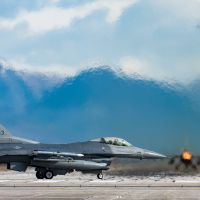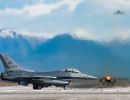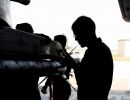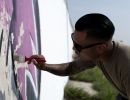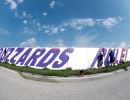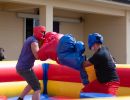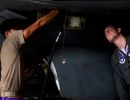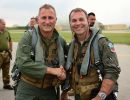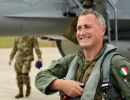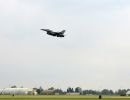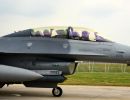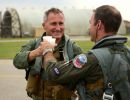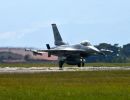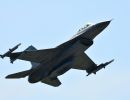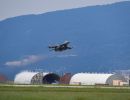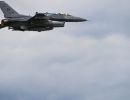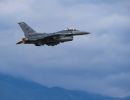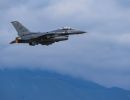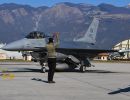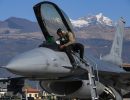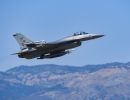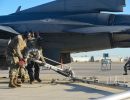The 405th Fighter Group moved across the English Channel from Christchurch, England to a small airstrip chopped out of an apple orchard near Picauville. The runway was surfaced with heavy tarpaper and was just wide enough for two airplanes to take off in a tight formation. The taxi strips and hardstands were wire mesh.
The runway was 3,800 feet long, which is 1,200 feet shorter that the tech orders for the P-47 specified. To make matters more difficult, we loaded our airplanes with as much as 1,750 pounds more bombs and other ordnance than the tech orders called for. Then we put about 1,500 more rounds of 50 cal. ammunition into the racks than was considered a normal load. All of this made for a considerable overload to be lifted off of a short runway that was soft when it rained.
And the take-off run of a P-47 could be an exciting experience. In the airplane's three-point position the huge engine cowling completely obscured the pilot's view of the runway ahead. A pilot pointed his airplane down the runway, locked the brakes, advanced the throttle to the stop until the engine was screaming to go and the plane shuddered with the strain. Then the brakes were released and the aircraft charged forward, rapidly gaining speed while, to keep his plane going straight, the pilot watched out the side, over the wing, at the edge of the runway as it raced past. When sufficient speed was reached to raise the tail, a little forward pressure on the stick dropped the nose enough to see over it and the end of the runway was visible for several seconds before arriving there. That position was maintained until enough speed was attained to lift the plane (about 120 miles per hour), then the landing gear was retracted as back pressure on the stick started a climb away from the ground. Usually we were airborne within 100 feet of the end of the runway with the wheels half retracted.
This brought about an interesting happening. On Sunday afternoon, people from the surrounding countryside would come to the airstrip to watch us take off on missions. Whole families would stand at the end of the runway so that the airplanes passed right over them about 50 feet high. One day Lt. Gene Ziegeweid and I walked up to the crowd and tried to point out that they were in a very dangerous position, but no one could understand what we were trying to tell them. Then a priest who was in the group came up and told us that he spoke some English and would try to make the people understand. So we explained to him that if one of the engines faltered just a little bit, these heavily loaded planes could crash and it would kill the whole village. The priest approached the crowd and, with much waving of his arms, warned them of their danger. Then, shaking his head, he came back to us and said, "They said to tell you that they trust you." Fortunately, we never did have and accident.
The effect of the war on the people living in the area was illustrated to us in the form of a little girl. We noticed her standing in the grass near our kitchen tent. A pretty child, about ten years old, she wore a ragged dress and huge shoes that had obviously been taken from a dead German soldier and her hands were clutched around the handle of a large bucket. She was obviously hungry and our cook, Sgt. Sing, finally realized that the girl hoped we would give her any left over food after we finished eating. Doc Milligan, our Flight Surgeon, spoke enough French to understand that her whole family had very little food and no way to get more. So Sgt. Sing filled up her bucket and Doc Milligan told her to come back at mealtimes every day. The girl became a regular customer of our kitchen. Our menus were not very fancy, but the food was healthy and a whole lot better than none at all. Mealtime also resulted in a bit of amusement. At breakfast and lunch we frequently had apple or strawberry jelly and occasionally some sort of sweet pudding at dinner. These sweet foods attracted large swarms of bees and hornets that became quite bold. The little insects would land right on a piece of bread and jelly and had to be waved away before a bite could be taken. It became a ritual - pick up the food, shoo the bee away and bite quickly before it came back. This, together with the mud when it rained, was why we named our Picauville air strip, "Hornet Bogg."
Reporters frequently stated that the air war was an impersonal thing for flyers. That may have been true of the bomber crews flying 12 to 25 thousand feet high, but it certainly did not properly describe the experience of fighter pilots flying close-support missions.. On one occasion, after shooting at a line of trucks, I leveled off in a tight turn about 50 feet above the ground. Looking down, I saw a German soldier swing his rifle, fire it just as I passed overhead and felt the bullet hit. I sensed no pain and could find no sign of blood, so the attack on the trucks was continued until ammunition was gone. After landing, I told my crew Chief, Sgt. Francis Jones, that I had been hit and he stuck his finger through a hole in the side of the plane about twelve inches below my left shoulder. The bullet had stopped in my parachute, about two inches from my back, which is why I felt it strike. That is getting very personal.
Then there was one of the times that the Squadron strafed a convoy of trucks. I fired a long, two-second burst into a large personnel carrier that was transporting at least 50 German soldiers. Flying just 100 feet over the truck at the end of the pass I looked down into the most awful carnage you can imagine. A 50-cal, armor-piercing-incendiary bullet will go through an automobile engine block, and about 96 rounds per second of them stream out of a Thunderbolt's guns. Just think of the terrible devastation which almost two hundred of those bullets had on human beings packed tightly into that truck. The effect was sickening and unforgettable.
Working at low altitude as we did during close-support missions, we frequently could see the gunners firing their 4-barrel, Vierling guns at us. On one occasion, I saw a gunner shooting at me and his shells were bursting so close, barely over my canopy, that another second and he would have had me. Lt. Bill Simpkins, who was flying my wing, saw it too, came in from the side and fired a burst that blasted the gunner and his weapon. That too was quite personal - for both the German gunner and me.
In Normandy, American troops were very close to the German lines - sometimes a single hedgerow separated them. Americans had big orange panels that they laid on the ground ahead of their positions so that we could locate our troops and not strafe them when we attacked close to the front. Also, the American soldiers would lay on their backs and we could tell they were ours. We shot up a large number of German replacements as they were moving into the battle lines because of information supplied to the U.S. Army by French resistance.
Probably the most significant event that took place while the 510th was at Picauville was the carpet bombing which broke the American troops loose from the hedgerows near St. Lo. Our part in the action was to dive bomb anti-aircraft weapons ahead of the heavy bombers. Timing was important because we had to do our work and be out of the area just before the bombers began their run. We were assigned specific gun emplacements and an exact time to attack them. Our take-off was only thirty minutes ahead of the bomber's approach to the target area. Major Parcell led the 510th on the mission and I flew his wing. Our take-off and approach to the target was routine and we were not opposed, right up to the time we began our dive-bomb run. We dropped our bombs and then searched the area for trucks, tanks, trains or anything else that moved.
As we climbed to clear out of the area as the bombers approached we could see the colored smoke shells bursting. The bombers sighted on the smoke and their bombs began exploding along the whole front. Great clouds of smoke and dust rose into the air and began drifting to the north on the south wind. The colored smoke drifted too and the bombers following the first wave sighted on it, not realizing that it had moved close to the Allied troops. The last wave actually dropped many of their bombs on our own troops and severe casualties resulted.
But the carpet bombing worked. Many German troops were killed or wounded. Most of those that survived the bombing were so dazed and disoriented that they were nearly helpless. Across the road from our field was an American Field Hospital and many of the German casualties were brought there for treatment of their wounds. They were really a pitiful bunch of soldiers.
As soon as the bombing stopped, American armor and infantry charged through the breaks in the German lines and both the First and Third Armies were loose in open country. General Patton's Third Army swept across Brittany and we ranged ahead of his tanks, shooting anything that moved. When they reached the city of Brest there were a few building on the outskirts that were occupied by German artillery. Dive bombing them did little damage so we would fly toward the buildings at about the level of the second floor and toss our bombs right through the windows. I was never subjected to a strafing attack so can't say from personal experience, but I'm sure that looking out a window with a Thunderbolt coming right at you with its guns firing must have been a terrifying feeling.
You inquire about personal experiences that may have been unique. Actually, there were very few things that happened to me that didn't happen to nearly all of us, but there is one that stands out in my memory.
It occurred on a mission that I led against a bridge somewhere in the vicinity of Laval. We were carrying 500 pound bombs and my wingman was Ed Mossman. My flight made the dive first and as we climbed away I looked back and saw that severe damage to the structure resulted. Anti-aircraft fire began bursting around us as the other two flights made their runs on the target. After the last plane cleared the area I led a strafing attack on some trucks traveling the road nearby. As Mossman and I reached about 1,000 feet, a voice screamed on the radio, "I'm hit, I'm bailing out!!"
I looked around for the rest of the planes and saw none of them flaming or out of control. I asked who was in trouble and where he was. Mossman answered, "I'm Red Two and I'm right behind you!" Moving to the side, I could see that my wingman's plane was indeed damaged, but was still under control. So I called to him, "Red Two, don't bail out yet. Let me get a look at your ship." Throttling back, I eased up beside him and saw that an AA shell had burst in the ammunition bay of the left wing and the cover was laid back with belts of ammunition trailing behind. Mossman was struggling to maintain level flight which was difficult because part of the wing was blanked out and the aileron was jammed. But he was managing the plane so I suggested that we try to climb a little and also get behind the Allied lines so that he would not be captured after bailing out. He agreed, so I ordered the rest of the Squadron to stay clear of us and told Mossman to head due north, that I would stay close to his wing to offer advice and encouragement and guide him toward safety.
We maintained about 200 MPH and gradually gained altitude. We were at about 5,000 feet when we reached the front lines. Mossman looked down, saw a U.S. truck and announced that the was going to bail out. I told him to wait a little longer so we could get closer to Picauville and would not have to drive so far to pick him up. When we reached the airstrip, Mossman again said he was bailing out, but I told him not do do it yet because the plane might crash into friendly troops. Instead, I suggested that we fly out over the Channel where the Navy could help him and the plane would crash harmlessly into the water. I ordered the rest of the Squadron to land. We finally crossed the coastline near Grandcamp and I suggested that Mossman open his canopy and try putting down his wheels and flaps to see if the plane could be slowed down enough to try a landing. The wheels and flaps were lowered and Ed carefully retarded the throttle until, at about 150 MPH, he could feel the beginning of a stall. Mossman called, "Red leader, I think I can land this thing, but I can't see because the windshield is covered with oil and when I tried looking out the side my goggles got full of oil."
I answered, "OK Ed, let's try this idea. You fly right off my left wing, with our wingtips only about three feet apart, and I'll lead you down to the runway." Mossman turned slowly back toward the airstrip and I positioned my plane close to his right wing. As we lost altitude I told him that we would approach the field at 160 MPH and I would lead him down so that he would be right over the center of the strip. Then I would tell him to cut his throttle and his plane should touch down quickly.
We circled the field once and I led him in a shallow approach to the field, making sure that his plane was centered on the runway. He passed over the end of the runway at about six feet and I ordered, "Cut it!!" Mossman yanked the throttle handle back and the plane dropped to the ground. He managed to keep the crippled ship straight down the runway and began gently applying brakes. The plane stopped rolling just a hundred feet from the end. He had done a masterful job of flying.
I pulled up and circled for my landing approach. After landing and parking The Touch of Texas, I filled out the Form One before looking across the taxi strip where Mossman had parked. His ground crewmen were laughing so I asked my crew what it was all about, because I sure didn't see anything funny in the experience we had just been through. Sgt. Jones, my crew chief, replied, "Go over and see for yourself Captain." I walked over to Mossman's ship and his crew chief handed me the plane's Form One. In it Mossman had written, "Severe damage to left wing. Shrapnel holes in cowling. Oil leak covering top of fuselage and all of canopy. Layer of thin shit in cockpit." Ed Mossman certainly had a great sense of humor. Unfortunately he was shot down and killed later that year in December.
One morning Sgt. Sing, our Squadron cook, asked me if I would help him with a project to which I agreed of course. He sawed a panel from the top of a paper gas tank in which we carried extra fuel - one that had not been used. He took the baffles out of the inside and hinged the panel he'd cut out so that it could be opened and closed. Into the tank he poured 50 gallons of powdered milk mix, ten gallons of mixed, canned fruit, ten pounds of sugar, some vanilla extract and a few other ingredients that I don't remember. All this was mixed thoroughly and the tank was hung under the wing of my plane. Sgt. Sing told me to fly up to 30,000 feet where the temperature would be about 30 degrees below zero F. I was to slip and skid the airplane around for half an hour to keep the contents mixed up until it froze, then dive down and land as quickly as possible. When I parked the airplane Sgt. Sing dropped the tank off the wing and opened it up to reveal ICE CREAM. Everyone had a feast.
Another party took place after the Falaise Gap action. Our airplanes had been so shot up that we were grounded for three days in order to make repairs. So Eugene Ziegeweid flew his airplane to do a check on the guns and claimed that the cow he shot was an accident. A couple of men took twenty pounds of white flour, some sugar and a few cartons of cigarettes in a Jeep with a trailer attached. They went to St. Lo and traded the sugar, flour and cigarettes for a two hundred fifty gallon keg of wine and some calvados. Sgt. Sing butchered the cow and cooked it in the form of roasts, steaks, chops and a huge pot of stew. By the time it was all eaten and the wine was all gone, we had a squadron full of pretty drunk men. Major Jenkins and I drove the Jeep and trailer around the base picking up guys who had passed out, so that they wouldn't get run over, and bringing them back to the safety of the Squadron area. By the next day everyone was back in fair condition and we got on with the job of repairing the airplanes.
On the subject of liquor, there was an interesting story that resulted from the kindness of a local farmer who gave us several gallons of calvados that he himself had made. While it was very smooth to drink, it was also especially potent - probably about 180 proof. Clyde Knisely was a replacement pilot who made himself somewhat unpopular by bragging about how much alcohol he could consume. So Bill Simpkins poured a glass of this calvados and offered it to Knisely who was doing some of his boasting at the time. Knisely drank the whole glass full, stood there for a few minutes before his knees began to buckle and he slowly sank to the floor where he remained all night into the next morning. His boasting stopped from then on.
Our base was shared with a British night fighter squadron which flew twin-engined, radar-equipped, de Havilland Mosquitos. Landing at night was dangerous because the runway was not lighted and airplane's landing lights were not used since they would attract German artillery which was close enough to hit us. The procedure was for a landing pilot to call in and report that he was on approach and at about 500 feet. A flood light was turned on and aimed down the runway for two seconds and, in that time, the pilot had to align his airplane and begin his flare-out for landing. The 405th did very little night flying, but when we did the same routine was followed. One very dark, moonless night a Mosquito called in to report his landing approach, got the flood-light flash, leveled out and settled down on top of another Mosquito that was also in the landing pattern and was directly under him. Neither pilot was aware of the other and both airplanes burned, killing both crew members of each plane.
To me, the most intense period of our stay at Picauville was during the Falaise Gap action. The Germans, trying to escape being encircled by Gen. Paton's 3rd Army and the British coming south from Caen, were caught bumper-to-bumper on the roads. We attacked with everything we had and the result was awesome. We would fly out, drop our bombs, then strafe until our guns were empty and return to the field to re-arm, re-fuel and take off again as quickly as possible. From the air, the roadways looked like ribbons of flame and smoke and above it all the sky was filled with anti-aircraft shell bursts. Of course we got shot up on every mission and our crew chiefs would repair holes in the airplanes with pieces of canvas cut from tents - while the armorers re-fuelled and re-armed the planes.
Naturally, we lost a lot of airplanes and pilots and the fear built up inside us so that a conscious effort was required to control it and climb into your plane for another mission. On one day I flew six missions between dawn and dusk, not even stopping for food. Like most of the pilots, I was so exhausted that my crew chief had to help me climb out of the cockpit at the end of the day.
It was during that period that I composed a prayer which became part of my cockpit check before every take-off. I would complete checking the instruments and engine and then say, "Dear Lord, out where I'm about to go, things could very easily get way beyond my ability to cope with them. And any help you might offer will surely be appreciated. Oh Lord, please hear me. Amen." I would finish my prayer with a Sign of the Cross and aim my plane down the runway. One of my friends claimed that he was an atheist and could not understand my praying. Without getting angry, we frequently argued on the subject of religion and the discussions went something like this:
"There is no God." "But Joe, where did all this world and everything in it come from?" "Well it wasn't created as you claim, it evolved over billions of years along with the rest of the universe." "All right, what did it evolve from?" "It all evolved from a singe cell." "And what was the source of that single cell?" "Well it wasn't created by some Supreme Being like you imagine, it came from a burst of energy in a cloud of gas." "OK, suppose you're right about that, where did the burst of energy originate?"
This argument could have continued forever, so long as we were both around to carry it on. During the horror of the Falaise Gap action, I was leading the Squadron on a mission and had parked at the end of the runway to get us assembled and test our planes. When I was ready to go I said my prayer, made the Sign of the Cross, looked back to be sure that everyone else was ready for take-off - and saw my friend Joe completing a Sign of the Cross.
I turned onto the runway and began the take-off run. As we flew out to attack, I thought to myself, "How easy it is to be independent of our Creator, to be completely self-sufficient when we are surrounded by civilization. When we're hurt, we call a doctor. When we're attacked, we call the police. When we're lost, we call for help. But where we were going, we would be all alone in our cockpits, beyond any sort of help if something went wrong." And I thought, "Does it not seem more logical to stay on good terms with my God all the time, rather than wait until I'm in trouble and then call for mercy?" I've tried to live by that philosophy ever since.
Shortly after the Falaise Gap missions we were pursuing the retreating Germans in the vicinity of Alencon and caught a convoy of armored vehicles on the road. Our formation got scattered as each pilot was searching for additional targets and, as a result, I found myself returning to base all alone with my guns empty and only about a fourth of my fuel left. Looking over my shoulder I saw a bunch of ME-109s diving to attack and I was defenseless. There was nothing to do but turn toward them and fake an attack of my own. Probably taken by surprise, none of them hit me on their first pass and then they had lost the advantage of speed and altitude. It was a pretty confused patch of sky as we all circled and tried for an advantage, with the ME-109s actually getting in each other's way. Quickly, there was an opening in their ranks and I leveled out, began a shallow dive, opened the throttle all the way to the stop and turned on the water injection. With no military weight on board and little fuel in its tanks, the Thunderbolt rapidly pulled away and left the Luftwaffe behind. They gave up the chase before I got back to Picauville and after I landed we could not find a single bullet hole in the plane. I was just plain lucky.
A couple of weeks later, the same thing happened, only the airplanes on that occasion were two P-51 Mustangs. Again, because the Thunderbolt was flying with very little load, it was able to outrun the attackers. This time they followed me all the way to the base and didn't break off until I buzzed the runway and they saw P-47s parked all over the place. I've often wondered how they explained the Thunderbolt that appeared on their gun-camera film - must have been embarrassing.
As I said at the beginning of this essay, my experiences were pretty much like most of the other pilots. Before ending, though, I must say something about the ground personnel. They were a magnificent group of people. We flew our airplanes way beyond the design limits as far as engine performance and speed were concerned, carried a lot more weight than should have been loaded, flew through trees on occasion, and violated every safety regulation in the book. But never once, did my airplane fail to perform, never did the engine fail to respond, always the guns fired to the aiming point, always the bombs released on command. My crew chief, Sgt Francis Jones, my mechanic, Sgt John lacovetta and my armorer Cpl. Stanley Stone were as skilled at their jobs as anyone could have been. They worked constantly to make sure that The Touch of Texas would be as effective a weapon as was possible. They, like all of the ground officers and enlisted men, were heroes.
Most of us were young, our average age was 23 years, and few of us had previous military experience. But we did our job. And it is a credit to the Training Command that they could transform a bunch of farmers, clerks, students, etc. into exceptionally skilled soldiers. And our commanders worked miracles in molding us into such an effective fighting force. We helped win the most awful war in human history.
Not realizing that the United States had the resolve, skill and willingness to oppose him was Hitler's most serious mistake. For we designed and produced the weapons needed, trained people to use them and built a merchant fleet capable of transporting weapons, fuel, food and soldiers to battlefronts all over the world and, at the same time, supplied allies and resistance fighters in occupied territories with the arms and equipment they required.
My family provided an interesting fact. I had a cousin who was a gunner in the German army. After VE Day, my grandmother contacted her relatives back in Coburg, Germany and learned that the cousin had been killed by a strafing Jabos.
Hitler proved that a dictatorship is the most efficient form of government, but that it is usually the most inhumane as well. The evil that man caused is incalculable.

